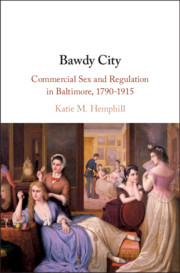Book contents
- Bawdy City
- Bawdy City
- Copyright page
- Dedication
- Contents
- Figures
- Acknowledgments
- Abbreviations
- Introduction
- Part I The Rise of Prostitution in the Early Republic
- Part II Regulating and Policing the Sex Trade
- 4 Policing the Expanding Sex Trade
- 5 “Our Patriotic Friends”
- 6 Prostitution, Policing, and Property Rights in the Gilded Age
- Part III Change and Decline in the Brothel Trade
- Conclusion
- Bibliography
- Index
6 - Prostitution, Policing, and Property Rights in the Gilded Age
from Part II - Regulating and Policing the Sex Trade
Published online by Cambridge University Press: 06 December 2019
- Bawdy City
- Bawdy City
- Copyright page
- Dedication
- Contents
- Figures
- Acknowledgments
- Abbreviations
- Introduction
- Part I The Rise of Prostitution in the Early Republic
- Part II Regulating and Policing the Sex Trade
- 4 Policing the Expanding Sex Trade
- 5 “Our Patriotic Friends”
- 6 Prostitution, Policing, and Property Rights in the Gilded Age
- Part III Change and Decline in the Brothel Trade
- Conclusion
- Bibliography
- Index
Summary
This chapter examines how the legal climate around prostitution in Baltimore changed in the wake of the Civil War. Growing fears about vagrancy following emancipation and the triumph of a free labor economy prompted crackdowns on streetwalkers and public sex workers, who found themselves incarcerated in the city’s growing network of carceral institutions. Meanwhile, real estate speculators’ growing disenchantment with brothels as investment properties and pressures from a growing urban middle class that expected the state to act as an active guarantor of their property rights brought challenges to the decades-old regime of toleration around indoor prostitution. Brothels, once regarded as a comparatively benign sexual labor arrangement because they kept illicit sexuality contained and out of sight, came to be firmly defined as threats to private property rights and to the future of the middle class. Authorities began to utilize the precedent set by an 1857 equity decision, Hamilton v. Whitridge, as they moved to crack down on sex workers and evict them from “respectable” neighborhoods. As they did so, they began to create informal red-light districts.
Keywords
- Type
- Chapter
- Information
- Bawdy CityCommercial Sex and Regulation in Baltimore, 1790–1915, pp. 170 - 196Publisher: Cambridge University PressPrint publication year: 2020



